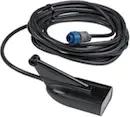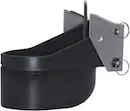What Is The Best Transducer For Lowrance? (2023 Guide)
UPDATED 11 MAY 2023
by Robert Ceran
This article may contain affiliate links. If you make a purchase after clicking on a link we may earn a small commission at no extra cost to you.
Not sure what Lowrance transducer to get for your fish finder?
Choosing the best Lowrance transducer is a challenging task, due to the fact that Lowrance has dozens of different transducer models on the market, each with different specs and functionalities.
To help you narrow down the search, my team and I tested the most popular Lowrance transducers on the market, and evaluated them based on the types of sonar included, range, frequencies, and overall performance.
Based on our testing, here are our picks of the best Lowrance transducers in 2023:
- Best 2D: HST-WSBL Skimmer
- Best 2D plus down scan: HDI Skimmer
- Best side scan: Active Imaging 2 in 1
- Best 3 in 1: Active Imaging 3 in 1
- Best for deep water: XSonic Airmar TM260
- Best 3D: StructureScan 3D
- Best for trolling motor: Active Imaging 3 in 1 Nosecone
- Best for HOOK2/HOOK Reveal: TripleShot Skimmer
- Best live sonar: Active Target
- Best thru hull: Xsonic Bronze HDI XDCR
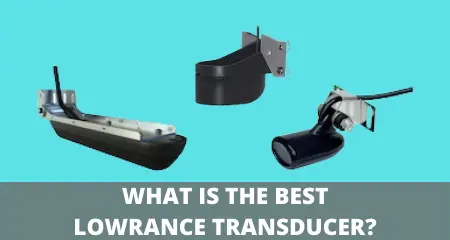
What is the best Lowrance transducer?
The table compares the key specs of the 10 best Lowrance transducers that we tested, as well as the application they are best suited for.
Now let’s dive into the details and take a closer look at each of these transducers:
HST-WSBL Skimmer


This is a classic 2D transducer, and comes with a built in temperature sensor.
One of its distinguishing features is its low cost, which makes it a great choice if you want to start with a basic transducer, or want to add 2D sonar as a separate transducer to your boat.
HDI Skimmer
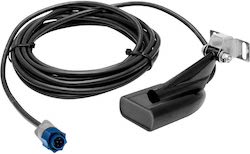

The HDI Skimmer is a more advanced Lowrance transducer that comes with both 2D and DownScan imaging, and is also capable of CHIRP sonar.
Compared to the HST Skimmer, the HDI also comes with additional high wavelength frequencies at 455 and 800 kHz, which can generate more resolution and detail.
Active Imaging 2 in 1
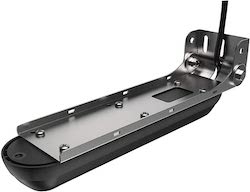

The Active Imaging 2 in 1 is a high quality transducer that includes both SideScan and DownScan.
Based on our testing, it’s a great option if you already have an HST or HDI Skimmer for your 2D sonar, and want to add side imaging into the mix.
Active Imaging 3 in 1


This is currently the most popular Lowrance transducer, and usually comes in the box when you get a new HDS Live or Elite FS unit.
The Active Imaging 3 in 1 includes 2D/CHIRP, SideScan, and DownScan, which means you have all your bases covered right off the bat for most fishing applications.
XSonic Airmar TM260


Our testing showed that this transducer is ideal for deep water, as it transmits low wavelength sonar at 50 kHz, which can penetrate much deeper than the customary 83 and 200 kHz sonar.
In fact, the XSonic Airmar can achieve depths over 1000 ft., which is plenty for most sportfishing applications.
StructureScan 3D


The StructureScan 3D comes with a sonar module that plugs into your fish finder display unit, which processes the sonar data from the StructureScan transducer to generate a 3D image of the underwater landscape.
Active Imaging 3 in 1 Nosecone


This transducer provides the Active Imaging 3 in 1 in a form that can be mounted at the bottom of a Ghost trolling motor. During our testing we found that it is superior to the standard HDI Nosecone that comes with the Ghost trolling motor, and in addition provides high quality SideScan sonar.
By using the SideScan functionality with a software update, you can also use this transducer for Ghost 360 imaging.
TripleShot Skimmer
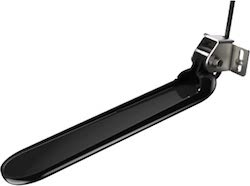

The TripleShot is Lowrance’s all in one transducer for the HOOK2 and HOOK Reveal series.
With 2D sonar/CHIRP, SideScan, and DownScan it comes with a full suite of all the major sonar technologies you can use with these fish finders.
Active Target
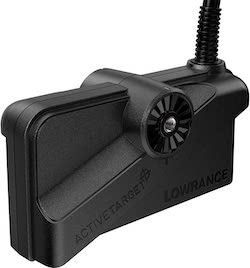

The Active Target live sonar transducer is Lowrance’s answer to Garmin LiveScope, and was released in 2020.
During our testing, the Active Target transducer generated high quality live sonar imaging that puts it on a par with LiveScope, and like the StructureScan 3D it also requires a module to process the sonar data before passing it on to a fish finder unit.
Xsonic Bronze HDI XDCR


This transducer is the best thru hull option, and comes with 2D/CHIRP, and DownScan sonar.
It can be mounted inside the hull and shoots its sonar through the hull.
How do you choose a Lowrance transducer?
In order to choose a Lowrance transducer, our tests revealed that you need to address the following 4 questions:
- What type of sonar do you want to use?
- What frequencies do you want to use?
- Where do you want to mount your transducer?
- What transducer models are compatible with your current Lowrance unit?
In terms of choosing a sonar type, the most important options are 2D, CHIRP, side imaging, down imaging, as well as live sonar.
Each of these sonar functionalities comes with its own strengths and weaknesses, and you may want to combine several of them to get the best results (which is most easily achieved with a 2 in 1 or a 3 in 1 transducer option).
Secondly, you’ll want to choose a sonar frequency based on the depth range that you want to target.
For deep water, you should choose low frequency sonar around 50 or 83 kHz, while 200 kHz or higher is better for mid range to shallow water.
Also, when you buy a transducer you need to decide the mounting option that you’ll be using (such as transom, trolling motor, or thru hull mount).
The most commonly used option is transom mounting, but each mounting option comes with its own pros and cons.
Finally, since Lowrance transducers are not universally compatible with all units, you need to make sure you choose a transducer model that is compatible with your Lowrance unit.
Can you upgrade your Lowrance transducer?
Yes, in many cases you can upgrade your Lowrance transducer, but you need to make sure that the new transducer is compatible with your current Lowrance fish finder unit.
So, in order to upgrade your transducer, you need to make sure that you choose a model that has additional capabilities that are supported by your fish finder.
For example, if you have a Lowrance HDS Live or Carbon fish finder, you could upgrade an HDI Skimmer transducer to an Active Imaging 3 in 1 transducer, since both of these transducers are compatible with your current unit.
Also, even if the new transducer you want to get is compatible with your unit, it may need a 7 pin to 9 pin adapter, since Lowrance changed all their transducers from 7 pin to 9 pin connectors a few years ago.
What does a TripleShot transducer do?
A TripleShot is a 3 in 1 transducer designed specifically for HOOK2 or HOOK Reveal units. It comes with 2D sonar, SideScan, and DownScan.
In addition to having single wavelength 2D sonar, TripleShot also comes with CHIRP, which scans across several wavelengths at the same time, resulting in more accurate images. Overall, this makes TripleShot the best all in one transducer option for HOOK2 and HOOK Reveal.
What is the difference between Lowrance SplitShot and TripleShot?
While TripleShot is a 3 in 1 transducer that comes with 2D/CHIRP, SideScan and DownScan, SplitShot is a 2 in 1 transducer that comes with 2D/CHIRP and DownScan.
So the main difference between SplitShot and TripleShot is that TripleShot in addition has SideScan.
What does a Lowrance 3 in 1 transducer do?
A Lowrance 3 in 1 transducer is an all-in-one transducer that comes with 2D, DownScan, and SideScan sonar.
Over the years Lowrance has produced several different 3 in 1 transducers, including TotalScan, StructureScan 3D, and most recently Active Imaging 3 in 1.
What is a 2 in 1 transducer?
A 2 in 1 transducer combines 2 different types of sonar in one transducer, such as the Lowrance SplitShot (which comes with 2D sonar and DownScan), or the Lowrance Active Imaging 2 in 1 transducer (which comes with DownScan and SideScan).
What is a Lowrance Active Imaging transducer?
Lowrance Active imaging transducers are the latest generation of 2 in 1 and 3 in 1 transducers produced by Lowrance that combine several different types of sonar in one transducer.
The Active Imaging 3 in 1 transducer comes with 2D/CHIRP, DownScan and SideScan, which covers all standard sonar functionalities that you might need. Currently, the Active Imaging 3 in 1 is the transducer that usually comes with HDS Live and Elite FS units.
Lowrance HDI transducer vs Active Imaging
The main difference between the Lowrance HDI and Active Imaging transducers is that most HDI transducers come with 2D and DownScan, while the Active Imaging 2 in 1 comes with SideScan and DownScan, and the the Active Imaging 3 in 1 comes with 2D, SideScan, and DownScan.
Lowrance Active Imaging 3 in 1 transducer vs TotalScan
The Lowrance Active Imaging 3 in 1 transducer is Lowrance’s latest generation of all in one transducers, and has replaced the TotalScan transducer since 2018.
In addition to higher resolution and better quality sonar images, the Active Imaging 3 in 1 transducer is also the option that usually comes in the box with brand new Elite FS and HDS Live units.
Lowrance Active Imaging transducer vs StructureScan 3D
The main difference between a Lowrance Active imaging and StructureScan 3D transducer is that the StructureScan 3D comes with 3D sonar imaging, while the Active Imaging does not.
Also, the Active Imaging transducer is plugged directly into your fish finder, while the StructureScan 3D transducer is plugged into a sonar module, which is in turn plugged into your fish finder.
The module processes the sonar data to create 3D images, which are then passed on to the fish finder display unit.
What is a Lowrance Active Target transducer?
A Lowrance Active Target transducer is a live sonar transducer that produces sonar images that are updated in real time, allowing you to see the movement of fish and your lure in the water as they occur.
This is in contrast to other types of sonar, which show you a historical image that is updated less frequently.
Lowrance Active Target vs Active Imaging
The main difference between Lowrance Active Target and Active Imaging is that Active Target generates live sonar images (updated in real time), while Active Imaging instead generates historical sonar images.
Gear and methods used for testing
For consistent testing results, we mounted all of the transducers reviewed above on the transom of a Ranger Z520R bass boat, or on a MotorGuide Xi5 trolling motor on its bow. We also tested each transducer over 3 consecutive days and on the same lake, to make sure we could compare their performance under similar conditions.


